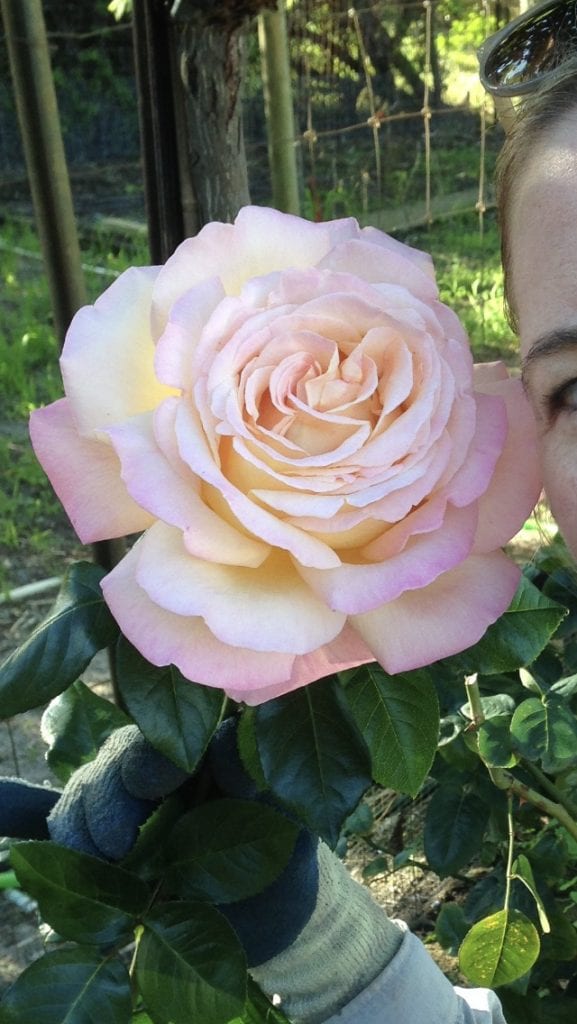The story of the ‘Peace’ rose is one that can be told over and over again because it encapsulates everything that we hold dear in roses – drama, love and greatness of spirit. Having past the sixtieth anniversary of the naming of this enduring rose, it remains an excellent garden rose, and a symbol of our desire for that ever-elusive peace. The creation of ‘Peace’ was beautifully chronicled in Antonia Ridge’s book ‘For Love of a Rose’ and it was something of a miracle that the rose ever saw the light of day.
In 1935, the French rose breeder, Francis Meilland, the third generation in a family of rose growers near Lyon, selected 50 ‘promising’ seedlings from his seedbeds. One was tagged 3 – 35 – 40 and over the next four years Francis and his father, Papa Meilland, watched its development with interest. In spite of war clouds gathering, the unnamed rose was introduced to friends and professional rose growers who gave it an enthusiastic ‘thumbs up’. But three months later Hitler invaded France and, with the nursery under threat of destruction, three parcels of budwood were hastily sent out of France, one of which was smuggled out in the diplomatic bag to America.
For the duration of the war the Meilland family had no idea whether any of the budwood had survived. In America their agent planted the rose in his own trial beds and gave it to other rose growers for testing in all the climatic zones throughout the United States. The rose did so well that it was decided to release it in the United States and thousands of plants were propagated. Although the war was still raging in Europe, the launch date was set for 29 April 1945, in Pasadena, California.
On the same day that two doves were released into the American sky to symbolise the naming of the rose, Berlin fell and a truce was declared. It was sheer coincidence. In naming the rose, this simple statement was read: “ We are persuaded that this greatest new rose of our time should be named for the world’s greatest desire: ‘PEACE’.”
‘Peace’ went on to receive the All American Award for roses on the day that the war in Japan came to an end. On May 8, 1945, when Germany signed its surrender, the 49 delegates who met to form the United Nations were each presented with a bloom of ‘Peace’ and a message of peace from the Secretary of the American Rose Society.
What is so touching about the story of ‘Peace’ is that back in France, the rose had been named ‘Madame Antoine Meilland’ in memory of Claudia Dubreuil, the wife of Antoine Meilland and mother of Francis. She had been the heart and mainstay of the Meilland family and died tragically young from cancer. At the same time news coming back from Germany and Italy where other budwood had been sent, revealed that in Italy the rose was called ‘Gioia’ (Joy) and in Germany, ‘Gloria Dei’ (Glory of God). For the family, all the names captured the qualities that they loved in Claudia.
The name ‘Peace’ seems to have outlasted all the others. The timing of its launch was perfect and it struck such a chord that within nine years some 30 million ‘Peace’ rose bushes were flowering around the world. But it wasn’t because of sentiment alone. ‘Peace’ truly was a superlative rose, superior by far to the roses before it in terms of vigour, hardiness, and the long lasting ability of its blooms. The colour was also magnificent, a pale, golden yellow deepening to red along the petal edges.
Its contribution to the rose world has been immeasurable. Because of its vigour and dependability, ‘Peace’ has been used in breeding programmes across the world. It is recorded that ‘Peace’ is the ‘mother’ in 150 varieties and the ‘father’ in a further 180 varieties. There would be many more if breeders always declared the parentage of new releases. Indeed it is probably safe to say that most of our modern roses are descended in some way from ‘Peace’. A few of the great garden roses that have ‘Peace’ in their lineage are: ‘Double Delight’, ‘Casanova’, ‘Blue Moon’, ‘Soaring Wings’, and ‘Electron’.
‘Peace’ also breathed new life into the gardening world, which sorely needed reviving after the war. The huge amount of publicity it received internationally made people excited about growing roses again. It has been said that ‘Peace’ is in every public park and the ‘must have’ variety for every garden. Because it grew so well and so easily, people were not afraid to try their hand at other roses and so the rose industry took off, once again.
Although new varieties, like ‘Iceberg’ have become even more popular, ‘Peace’ is still a good garden rose with glossy green leaves and well shaped blooms that are slightly lighter than their European counterparts because of our bright Australian sunlight.
Francis Meilland died in 1958 but his son Alain and daughter Michelle and their children continue the Meilland tradition of breeding roses. After ‘Peace’ became so well known, Francis wrote in his diary: “How strange to think that all these millions of rose bushes sprang from one tiny seed no bigger than the head of a pin, a seed which we might so easily have overlooked, or neglected in a moment of inattention.”
That’s the miracle of the rose!
